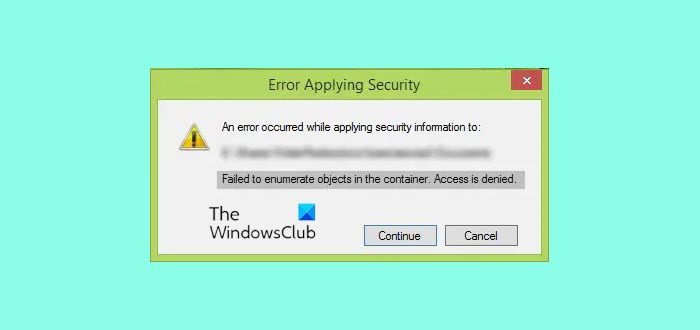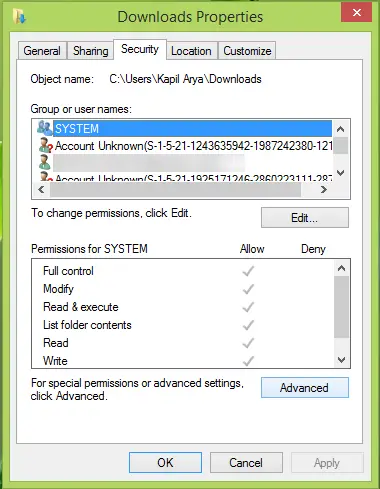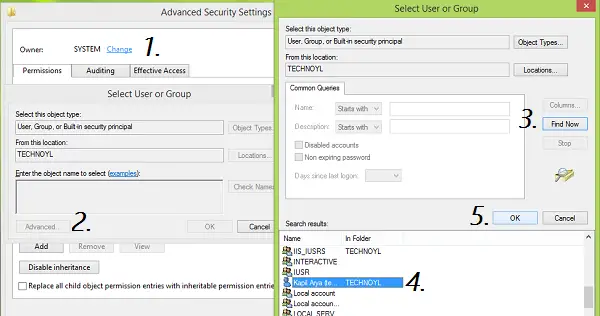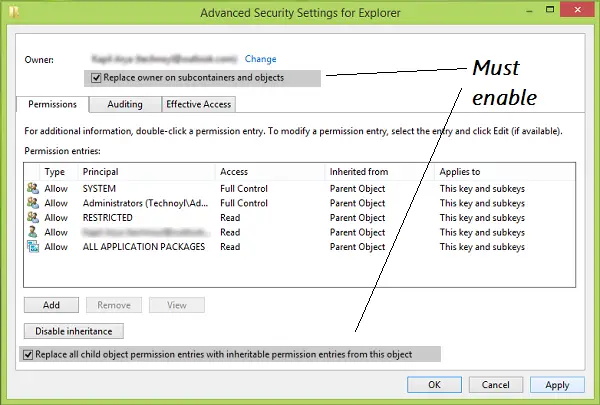If you cannot change the permissions of objects & receive Failed to enumerate objects in the container, Access Is Denied error in Windows 11/10, then this post will be able to help you.
Generally in Windows, permissions help us to keep content private or public. Thus it is very easy for us that we assign such permissions to our files and folders, such that others may invoke or not, according to the requirement. The permissions for folders/files can be changed by right-clicking on folders/files and selecting Properties. From here by switching to the Security tab, we can configure the permissions.

How do I fix Failed to enumerate objects in the container, Access is denied?
The Container error message can appear due to Permission issues or entries. The file or folder permissions for the current owner may not allow this. You may therefore need to check the child object permission entries.
However, sometimes due to a clash of permissions or incorrect settings, you may not be able to changes permissions and face errors while doing so. In such scenarios, the following error is most common:
Failed to enumerate objects in the container, Access is denied
You’re more likely to face this error when you’re not the owner of the content, whose permissions you’re changing about. Thus in such cases, the following are the exact steps you should take to avoid the error. You can do it in either of the three ways:
1] Changing Folder Permissions
1. Firstly, right-click over the folder/file whose permissions you’ve to change. Select Properties.

2. Next, in the Properties windows, switch to Security and hit Advanced option there.

3. Moving on, in the below-shown screen, you have to click number-wise to follow the sequence. That is, first click Change link for Owner in the Advanced Security Settings window.
Then click Advanced option in Select User or Group window, and then click Find Now in another window so opened.
Here you need to select your user account under the Search Results so listed.
Then click OK > OK > Apply > OK.

4. The previous step takes you back to the window shown in step 2, hence click Advanced option there.
Now in the Advanced Security Settings, you must check Replace owner on subcontainers and objects and Replace all child object permissions entries with inheritable permission entries from this object.
Click Apply followed by OK.

Thus finally, you can change permissions the window shown in step 2. No error would be encountered by you now.
Having done this, you need to again open the Properties window > Security tab > Advanced > Permissions > Add > Select principle > Enter your user account name > OK.
Do note that when you change Permissions, it does make your PC a ‘bit less secure’.
2] Using Command Prompt
Create a system restore point first and then open an elevated command prompt window and execute the following command one after the other:
takeown /F X:\FOLDER-PATH
takeown /F X:\FOLDER-PATH /r /d y
icacls X:\FOLDER-PATH /grant Administrators:F
icacls X:\FOLDER-PATH /grant Administrators:F /t
By running these commands, you will have changed user folder permissions.
3] Disable UAC
If you are unable to change the Permission, then you need to change UAC settings. Make it Never notify. Once you have carried out the set task successfully, you may revert UAC settings to default.
However, we do not recommend that you disable the User Account Control permanently to suppress such warnings as the UAC has a larger role to play in securing your computer.
Let us know if this works for you.